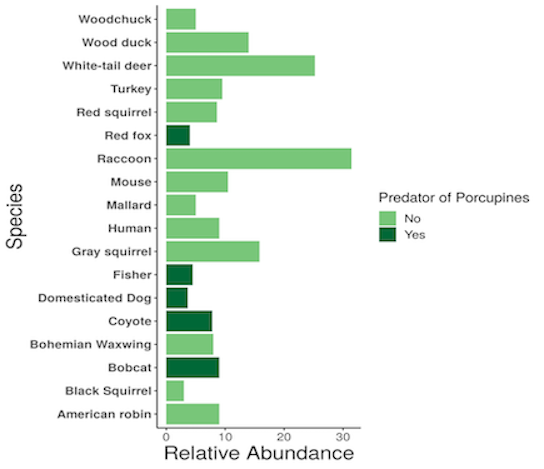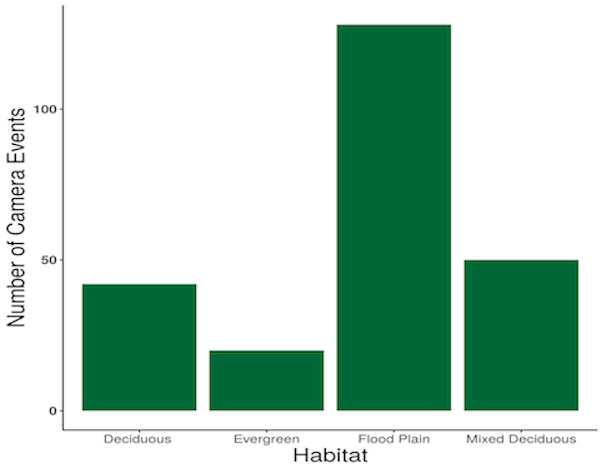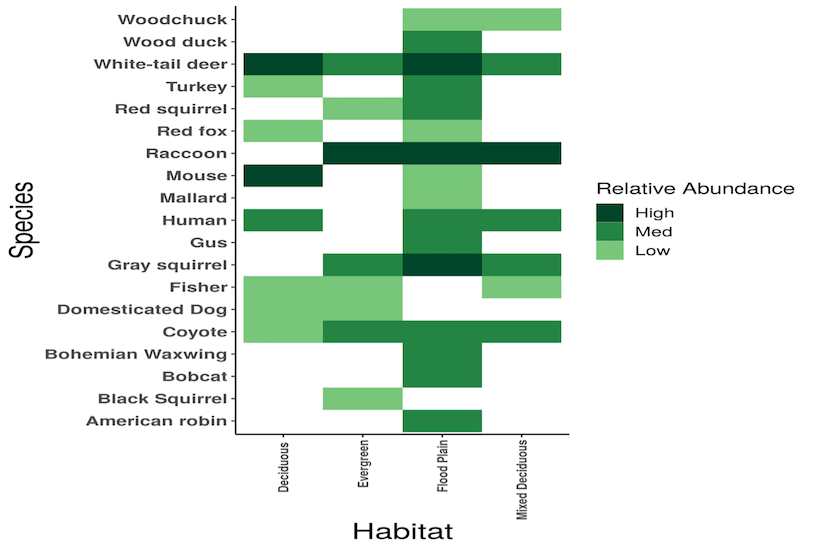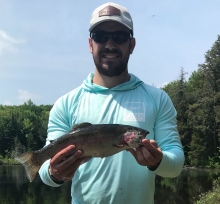What is causing low porcupine abundance?
After spending the semester conducting research, I finally have a story to tell about the current state of porcupines on the St. Lawrence University Kip tract. I used game cameras to take pictures of wildlife and recorded what species I saw. I had over 20 different species captured on camera, but the one species I did not have a single picture of was the porcupine. There is a concern that porcupines are in a decline across their range, so no pictures of porcupines is concerning for the population on the Kip tract. Although there were no pictures, it does not mean that porcupines have completely disappeared from the tract. However, it is concerning because the number may be low, leading to no pictures.
My first graph shows how likely it is that each species will be caught on camera if a camera was left out for 100 nights. The x-axis, relative abundance, makes it possible to determine how frequent species are relative to one another in an area. Within the graph, the dark green signifies a predator of porcupines. As I talked about in my first blog, fishers are the main predators of porcupines. Porcupines have over 30,000 quills making it hard for predators to snack on them without sustaining injuries. Fishers are better than most predators at not getting a quill in the eye or mouth which is why they are the main predators for porcupines. Fishers are able to flip porcupines over and snack on the porcupine without getting poked. Porcupine abundance decreases when fishers are present in an area. You might notice that I listed the domesticated dog as a predator. Although dogs do not actively seek to eat porcupines, dogs still bite porcupines. The red fox is the next lowest-occurring predator of porcupines. Red foxes are mammals that have a red fur coat, and a big bushy tail. Red foxes are not picky eaters, so they will eat anything that is available. Unlike the fisher, red foxes cannot obtain porcupines as easily because red foxes are not as agile as fishers and end up getting poked by porcupine quills.The coyote is a common predator found on the Kip tract. Coyotes are dog-like predators that also feed on a wide range of prey, including porcupines when they are desperate for food. Snowshoe hares are coyotes’ go-to snack. When hares are not abundant, coyotes have been shown to increase their predation on porcupines.
The most common predator I detected was the bobcat. Bobcats are like the other predators listed because bobcats eat a wide range of prey. Hares are the most common prey for bobcats, but bobcats occasionally target porcupines as a main prey item. Quills from porcupines were found to pass through a bobcat’s digestive system with no apparent effects on the bobcat.
What a stressful life porcupines have! The abundance of different predators on the Kip tract could explain why I did not detect any porcupines in my research. Porcupines could be too stressed to search for food and their range could be smaller because of predators in the area.

I put cameras in four different habitat types within the Kip tract (you can read more about my research methods here). My second graph breaks down which habitats had the most camera events. When the camera is triggered, it takes 3 quick pictures, which together are considered one “event”. The highest number of camera events was in the floodplain habitat. Floodplains having the highest number of camera events is no surprise. The Little River runs through the heart of the Kip tract, so most of the land in the tract is floodplain habitat. Floodplains are biodiversity hotspots because of the different functional dynamics that occur there and sometimes are compared to tropical rainforests in terms of biodiversity (the number of different species in an area). Floodplains are inundated with water when the river is high, and when the river is low function more like upland deciduous or evergreen habitats by having more terrestrial species. The alternating functions of floodplains make them favorable for both terrestrial and aquatic species. These species can consist of generalists (species that can survive under a wide range of habitat conditions) and specialists (species that can only survive under certain habitat conditions). Mixed deciduous forests was second in total number of camera events. Mixed deciduous forests are made up of deciduous trees (trees whose leaves fall off during autumn) and evergreen trees (trees whose leaves/needles do not fall off during autumn). Mixed deciduous forests are relatively high in biodiversity due to the mix of two different habitats. Different herbivorous (plant-eating) mammals and insects prefer specific tree species within mixed deciduous forests. These forests play an important role in climate change because of their ability to capture a lot of carbon. Since both deciduous species and evergreen species exist in mixed deciduous forests it makes sense that there were many camera events for this habitat because biodiversity is high. Deciduous forests had the third-highest number of camera events. Deciduous forests have moderate levels of biodiversity. Biodiversity levels are moderate because of the seasonal changes that deciduous forests undergo. Summertime is when activity is the highest in these forests because of rainfall and warmer temperatures. During the winter the trees lose all their leaves because of the lack of precipitation and colder temperatures and photosynthesis stops. Food is scarce in deciduous forests during the winter causing some animals to hibernate and many birds to migrate. Since my semester research was done primarily in the winter, there was less activity in deciduous forests which could explain the low number of camera events. The habitat with the fewest camera events is the evergreen habitat. Evergreen habitats generally have lower biodiversity compared to other habitats. Evergreen trees can grow in conditions other trees cannot, like dry and sandy soils. Evergreen trees grow slowly and live longer than other trees. The needles on evergreen trees have lower nutrient requirements which cause the tree to grow slowly. Evergreen habitats are critical for the animals and birds that stay during the winter because evergreen habitats provide food for those species all winter long.

Graph of the number of camera events for each habitat.
My third and final graph combines my previous two graphs into one. If a species is found within a habitat it is shown by a green rectangle. The color of the rectangle shows how often that species would be captured on camera with darker colors portraying a higher abundance. Fishers were found in three out of the four habitats with low abundance. The red fox was found in deciduous and floodplain habitats at low abundance. Coyotes were found in all four habitats, with medium abundance in three and low abundance in deciduous forests. Bobcats were found in medium abundance in floodplain habitats. Humans (or hikers) were found in medium abundance in deciduous, mixed deciduous, and floodplain habitats. Domesticated dogs were found in low abundance in deciduous and evergreen habitats. Looking at this graph, I determined that there is no habitat where porcupines can avoid predators. Predator abundance in all habitats could be the reason no porcupines were caught on camera.

Graph of species found in each habitat and how frequently each species is found in those habitats. Gus is our research lab dog!
Though I didn’t detect any porcupines with my camera traps, we know that there are at least a few on the Kip tract. One seems to inhabit a very large oak tree along the main trail, and my professor has seen fresh signs. She also got a video of porcupines on a different set of camera traps she had deployed for another reason. Knowing this, I determined the abundance of porcupines must be low since I did not find any on my cameras.
It is sad that I was unable to find any porcupines during my research this semester, but this finding only brings attention to the concern over porcupine populations declining. Although there are low porcupine numbers on the Kip tract, there are some positives to my research. My findings show that the Kip tract is full of life. There were 19 documented species captured on camera and many other species have been seen in the field. Biodiversity draws people into nature because of the beauty it can create. I encourage everyone to go and experience the biodiversity that is found in a place near you, but while you enjoy that place be aware that biodiversity and the outdoors are in danger. More needs to be done to keep biodiversity high globally and the most important step is caring about and connecting with nature. Together, we might be able to end the story of the biodiversity crisis with a happy ending.
[Note to readers: This is the third installment of a series of 3 blogs shared by Peyton Schmitt '23, about research he conducted during the spring term of his senior year at St. Lawrence University. Check out Part 1 and Part 2 !]

